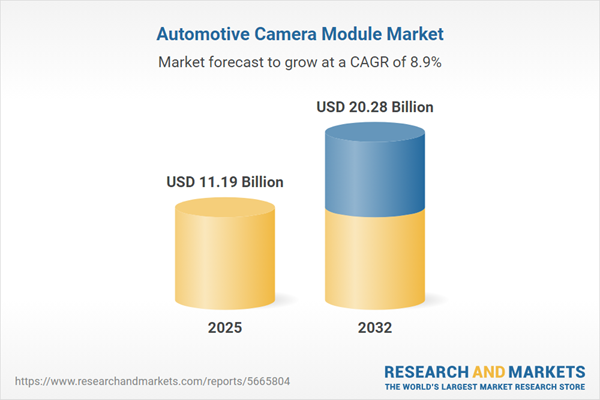Speak directly to the analyst to clarify any post sales queries you may have.
The automotive camera module market is emerging as a strategic priority for organizations seeking to improve vehicle safety, operational efficiency, and adaptability in a fast-evolving regulatory and technological environment. Market leaders are focusing on how to leverage advanced imaging solutions to optimize resources and support data-driven fleet management.
Market Snapshot: Automotive Camera Module Market Overview
The automotive camera module market recorded a revenue of USD 10.27 billion in 2024, with expectations to reach USD 11.19 billion in 2025 and a projected rise to USD 20.28 billion by 2032. This significant market growth reflects the direct impact of evolving global safety regulations, rapid advancements in sensor technologies, and the increasing integration of camera-based advanced driver assistance systems. As automation gains traction, industry players are refining their operating models and redefining their roles within a competitive international landscape shaped by policy shifts and a rising emphasis on connected mobility.
Scope & Segmentation: Key Drivers in the Automotive Camera Module Market
This analysis equips senior decision-makers with a focused view of the main segments and drivers influencing strategic investment and resource allocation across the automotive camera module value chain.
- Camera Types: Cabin cameras are essential for monitoring interior activities and driver behavior. Front and rear cameras enhance external awareness, while surround-view systems support navigation and obstacle avoidance, particularly in urban areas.
- Applications: Camera modules are integral for adaptive cruise control, emergency braking, night vision, driver alerts, advanced parking aids, and higher-level automation features, benefitting OEMs and fleet operators.
- Sensor Technologies: CCD and CMOS sensors are fundamental components. Improvements in illumination technology ensure clear imaging in diverse environments and operational conditions.
- Vehicle Types: Passenger cars, light commercial vehicles, and heavy-duty fleets require specialized camera integration to comply with the varying standards and regulatory landscapes dominant in each segment.
- Sales Channels: Direct partnerships with OEMs and robust aftermarket channels facilitate both the deployment in new vehicle models and seamless upgrades for existing fleets.
- Regional Coverage: Americas, Europe, Middle East & Africa, and Asia-Pacific represent distinct regulatory frameworks, adoption rates, and investment climates, all influencing camera module adoption and adaptation strategies.
- Key Players: Leading companies such as Robert Bosch GmbH, Continental AG, DENSO Corporation, Aptiv PLC, Valeo SA, Magna International Inc., Panasonic Corporation, Samsung Electro-Mechanics, LG Innotek, and Hella GmbH & Co. KGaA are channeling resources into collaborative development and global technology leadership.
Key Takeaways for Senior Decision-Makers
- Automotive camera modules serve as a foundation for improving operational performance across varied vehicle categories and facilitating the transition to connected and automated mobility.
- AI-powered analytics are expanding the role of automotive cameras by enhancing image interpretation and prompt system responses in complex driving environments.
- Strategies emphasizing localized manufacturing and compliance enable organizations to adapt effectively to regulatory variation and market-specific requirements.
- Partnerships among OEMs, tier suppliers, and technology companies are reinforcing supply chain stability and expediting product innovation cycles, creating a robust foundation for future developments.
- Adoption of modular system architectures simplifies camera integration for both newly manufactured vehicles and retrofitted fleets, supporting scalability and agile deployment strategies.
- Implementing interoperable, data-centric systems enables organizations to stay compliant against shifting regulations while leveraging advancements in connectivity and automation for competitive advantage.
Tariff Impact: Addressing Supply Chain Risk
Shifts in tariffs, especially those affecting U.S. imports of essential semiconductor and optical components, have heightened the complexity of supply chain management in the automotive camera module segment. Market participants are proactively renegotiating supplier contracts, increasing their focus on localized sourcing, and optimizing logistics operations to minimize potential disruptions. By adapting supply strategies, companies ensure steady access to mission-critical materials, maintain operational continuity, and keep development timelines stable despite evolving policy scenarios.
Methodology & Data Sources
This report synthesizes data from executive and engineering expert interviews, alongside procurement leader feedback. Market surveys, detailed regulatory analysis, official company communications, and patent filings inform the triangulation process, providing actionable and dependable insights for executive teams.
Why This Automotive Camera Module Market Report Matters
- Empowers leadership to proactively navigate regulatory and technology advances, improving long-term strategic decision-making and risk management for automotive technology investments.
- Supports robust compliance benchmarking and supply chain resilience planning, enabling more informed choices for market entry or operational realignment.
- Reveals partnership and investment opportunities that drive sustainable innovation and growth, ensuring continued relevance in a rapidly transforming automotive sector.
Conclusion
With granular market segmentation and actionable insights, senior leaders are equipped to strengthen operational resilience and maintain agility as industry-wide changes reshape the automotive camera module market landscape.
Additional Product Information:
- Purchase of this report includes 1 year online access with quarterly updates.
- This report can be updated on request. Please contact our Customer Experience team using the Ask a Question widget on our website.
Table of Contents
3. Executive Summary
4. Market Overview
7. Cumulative Impact of Artificial Intelligence 2025
Companies Mentioned
The companies profiled in this Automotive Camera Module market report include:- Robert Bosch GmbH
- Continental AG
- DENSO Corporation
- Aptiv PLC
- Valeo SA
- Magna International Inc.
- Panasonic Corporation
- Samsung Electro-Mechanics Co., Ltd.
- LG Innotek Co., Ltd.
- Hella GmbH & Co. KGaA
Table Information
| Report Attribute | Details |
|---|---|
| No. of Pages | 184 |
| Published | October 2025 |
| Forecast Period | 2025 - 2032 |
| Estimated Market Value ( USD | $ 11.19 Billion |
| Forecasted Market Value ( USD | $ 20.28 Billion |
| Compound Annual Growth Rate | 8.8% |
| Regions Covered | Global |
| No. of Companies Mentioned | 11 |









